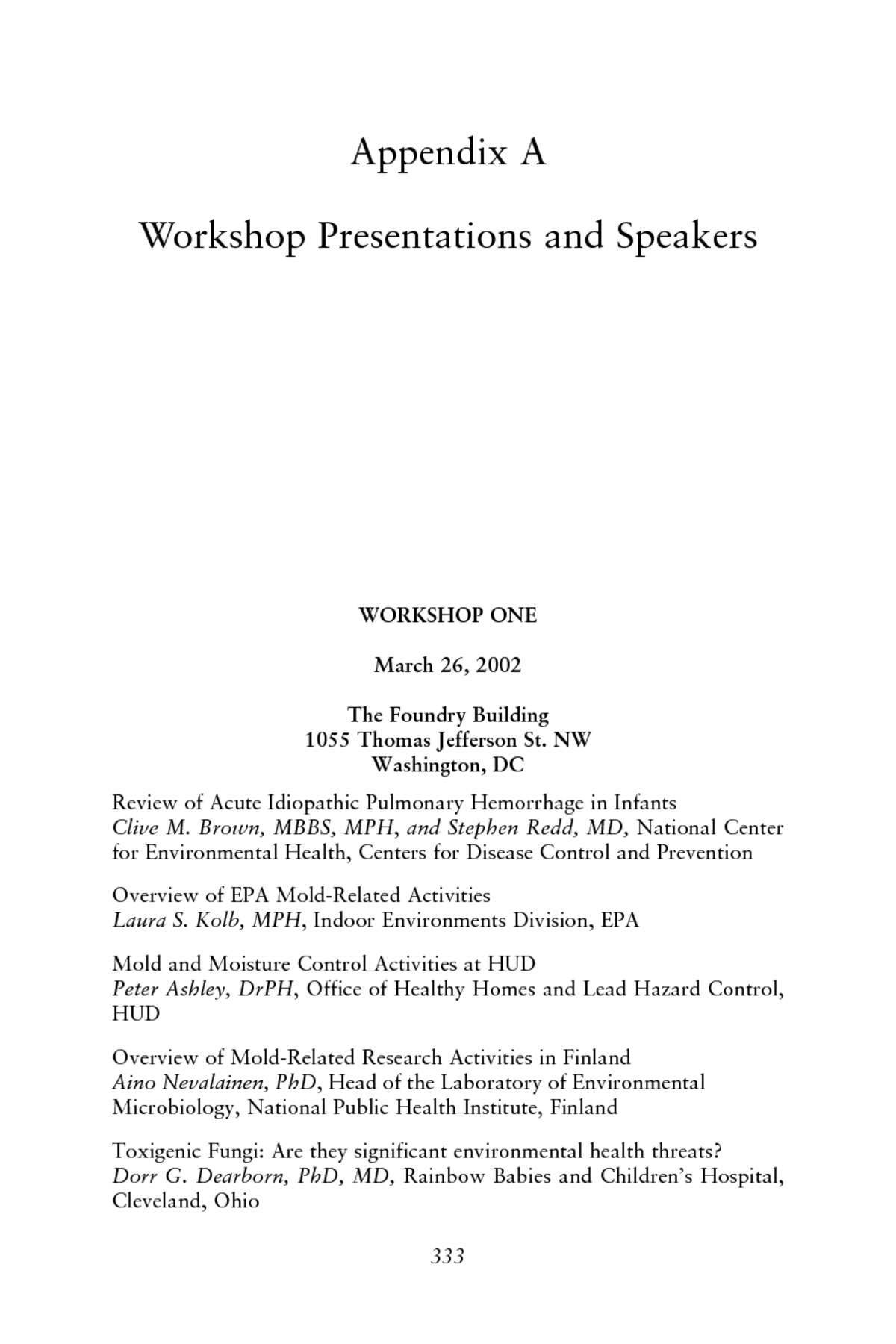Below is the uncorrected machine-read text of this chapter, intended to provide our own search engines and external engines with highly rich, chapter-representative searchable text of each book. Because it is UNCORRECTED material, please consider the following text as a useful but insufficient proxy for the authoritative book pages.
Appendix A Workshop Presentations and Speakers WORKSHOP ONE March 26, 2002 The Foundry Building 1055 Thomas Jefferson St. NW Washington, DC Review of Acute Idiopathic Pulmonary Hemorrhage in Infants Clive M. Brown, MBBS, MPH, and Stephen Redd, MD, National Center for Environmental Health, Centers for Disease Control and Prevention Overview of EPA Mold-Related Activities Laura S. Kolb, MPH, Indoor Environments Division, EPA Mold and Moisture Control Activities at HUD Peter Ashley, DrPH, Office of Healthy Homes and Lead Hazard Control, HUD Overview of Mold-Related Research Activities in Finland Aino Nevalainen, PhD, Head of the Laboratory of Environmental Microbiology, National Public Health Institute, Finland Toxigenic Fungi: Are they significant environmental health threats? Dorr G. Dearborn, PhD, MD, Rainbow Babies and Childrenâs Hospital, Cleveland, Ohio 333
334 DAMP INDOOR SPACES AND HEALTH Damp Indoor Spaces Investigation and Remediation Terry M. Brennan, MS, Camroden Associates, Inc., Westmoreland, New York âToxic Moldâ: History and Measurement John H. Haines, PhD, New York State Museum, New York State Biological Survey, Albany, New York WORKSHOP TWO June 17, 2002 Keck Center of the National Academies 500 Fifth Street NW Washington, DC Indoor Damp Spaces Epidemiology Bert Brunekeef, PhD, Professor of Environmental Epidemiology, Institute of Risk Assessment Sciences, University of Utrecht, Utrecht, The Netherlands Experimental Methods to Assess the Pulmonary Effects of Fungi Carol Y. Rao, ScD, National Institute for Occupational Safety and Health, Division of Respiratory Disease Studies, Field Studies Branch, Morgantown, West Virginia Consultantâs Viewpoint on Mold John A. Tiffany, MS, President, Industrial Hygienist, Tiffany-Bader Environmental, Inc., Lawrenceville, New York WORKSHOP THREE October 8, 2002 J. Erik Johnson Woods Hole Center 314 Quissett Ave. Woods Hole, MA Clinical Issues Eckardt Johanning, MD, MSc, Occupational and Environmental Life Science, Fungal Research Group, Inc., Albany, New York
APPENDIX A 335 Toxicology Joseph Brain, SD, Cecil K. and Philip Drinker Professor of Environmental Physiology, Department of Environmental Health, Harvard School of Public Health Limiting Conditions for Fungal Growth on Building Materials Susan C. Doll, ScD, Department of Environmental Health, Harvard School of Public Health



